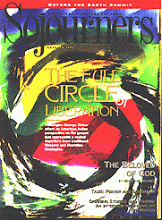Nada te turbe, nada te espante: quien a Dios tiene nada le falta. Nada te turbe, nada te espante: solo Dios basta. (Let nothing trouble you, let nothing frighten you: whoever has God lacks nothing....God alone is enough.)
The words of the chant rose up to fill the spacious room with a peaceful, sacred harmony as thousands of young adults sang them in unison.
At the front, dozens of flickering, uniquely shaped candles illuminated the scattered icons and wildflowers that formed a makeshift altar. For one brief weekend, this fieldhouse at the University of Dayton in Ohio had been converted into a dimly lit sanctuary of prayer, a place where 2,000 young (and some not-so-young) adults gathered for a "pilgrimage of trust on Earth."
This gathering, organized by the ecumenical community of Taize, was the first of its kind in North America--though such meetings have been held in European cities for more than 10 years. "Pilgrims" from 46 states as well as places as far away as Poland, Bosnia, Mexico, the Philippines, Uganda, and India came to Dayton to pray and begin to discover together what it means to be agents of trust and reconciliation.
Prayer, trust, and reconciliation are long-standing themes of the Taize community, based in eastern France. In 1940, the community's founder, Roger Schutz, a young theology student at the time, left his native Switzerland to begin giving refuge to Jews fleeing Nazi-occupied areas. Roger says his purpose in going to Taize was the call he felt as a Christian to be a living sign of reconciliation among the human family. His call attracted other young adults who soon joined him in his work of providing hospitality and building human solidarity. In 1944, Roger and a few others committed themselves to a monastic-style life in the tiny farming village.
Read the Full Article

